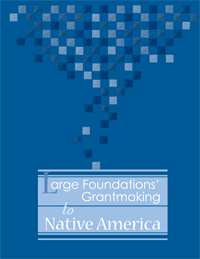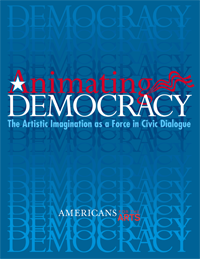Cultural Policy
2010, 138 pages, Americans for the Arts, 1000 Vermont Ave. NW, Washington, D.C., 20005, (202) 371-2830 http://www.artsusa.org
Download:
Read More...This handbook describes how partnerships between local cultural agencies, schools, businesses, and other sectors of the community can make a positive impact on arts education. Learn how 11 communities built their local partnerships, and how you can adapt similar programs to your community.
40pp, saddle-stitched paper (1995, Americans for the Arts' Institute for Community Development and the Arts)
Available online from Americans for the Arts
Read More...Ralph Smith, the 2007 Conference Chairman, issued a challenge in his welcome message – “that all who attend will leave with renewed energy, capacity and resolve to make a positive contribution toward meeting the challenges of our time.”
Read More...This brief presents research findings as well as policy recommendations arising from a study of the No Child Left Behind Act and its implications for immigrant children and English language learners (ELLs). Analyses are based on nationally-representative data from the Schools and Staffing Survey and detailed case studies of selected elementary schools and school districts serving high concentrations of ELL students. Results reveal an extraordinary degree of concentration of ELL students in a few schools that tend to be large, urban and serve a predominantly minority student population.
Read More...Native America at the new Millennium is a Ford Foundation-funded collaboration by the Harvard Project, Native Nations Institute, and First Nations Development Institute that serves as a primer on contemporary American Indian affairs. NANM addresses topics as wide-ranging as tribal government, non-profit organizations, political activism, economic development, housing, welfare, health, arts, and media.
Read More...More than 100 sources were interviewed, consulted, or literature reviewed for information for this study on Native American Philanthropy.
"Native communities have always practiced various forms of giving, from rituals and religious ceremonies to auctions and art fairs." Read on as this study explains how Native American communities have always been involved with, and are increasing their visibility in philanthropy.
Download pdf from Native Americans in Philanthropy.
Read More...First Nations Development Institute and Native Americans in Philanthropy convened a group of Native philanthropic leaders in Minneapolis/St. Paul on September 14 2005, to discuss how we can better support the development of Native foundations and Native philanthropy. The objective of this meeting was to provide insight and input into the design and implementation of a structure to support the further development of Native foundations and Native philanthropy through technical assistance, advocacy and research.
Read More...A Native critique of American life, featuring the best of Indian Country Today's editorials and perspectives since 2000. Contemporary Native thinkers and writers meet the dominant issues in both Indian and non-Indian public life head-on in this unique publication. The book is a must-read for anyone who needs a contemporary view of the major issues affecting tribal communities across the country.
Available from Indian Country Today.
Read More...
This report presents key findings from a study of large foundations' giving to Native American causes and concerns. It addresses the real dollar value of grantmaking from 1989-2002, top donors and top recipients, and the general purposes to which grants are targeted. The pamphlet concludes with a discussion of what the data imply (and in particular, what action they ought to motivate) for foundations, Native-serving nonprofits, and tribal governments.
Read More...The story of how the Boston Foundation became the first community foundation to develop and implement policy on exercising its proxy votes on investments to advance its mission.
Posted courtesy of Stanford Social Innovation Review
Download:
![]() What Works (5.9Mb)
What Works (5.9Mb)

